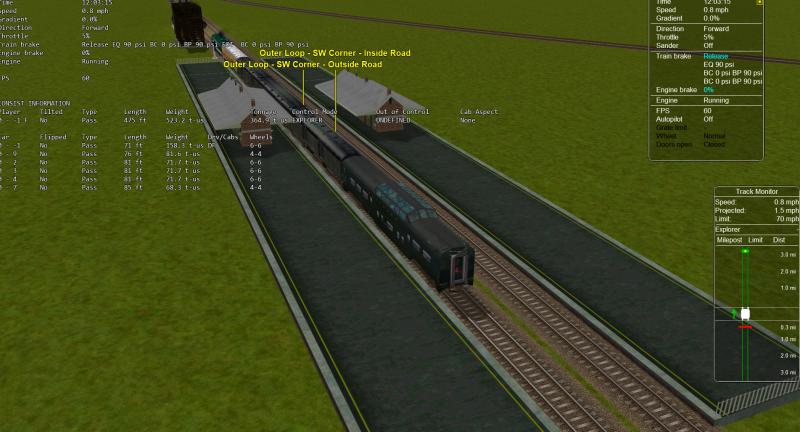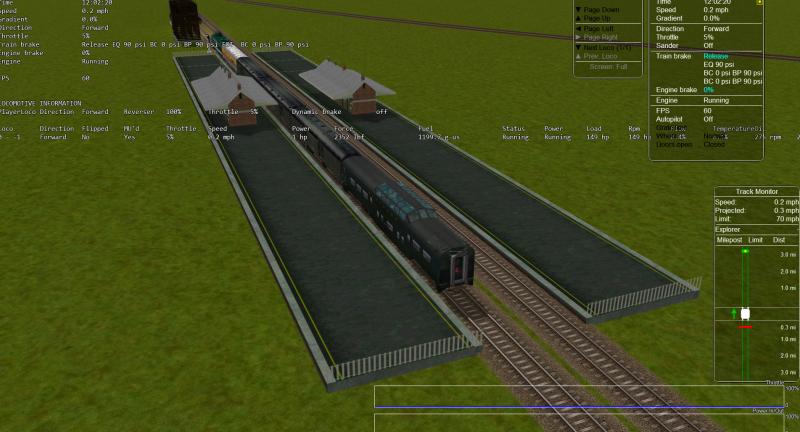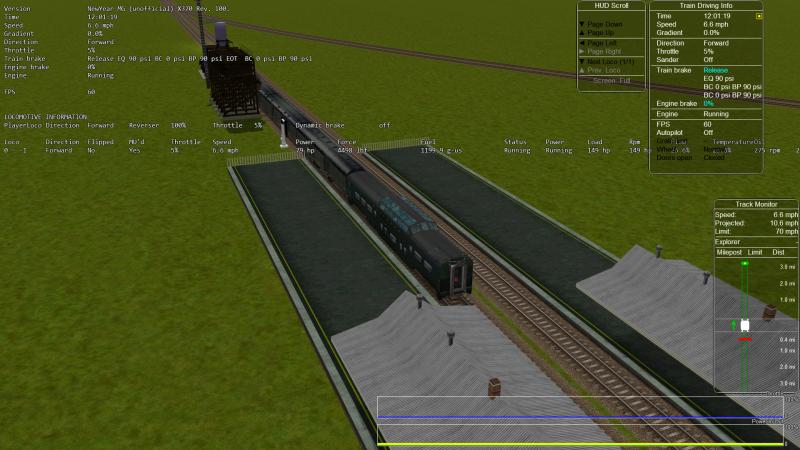Eng Files for USA diesels Looking for data...
#31

Posted 21 August 2021 - 05:06 PM
Could you show a manual that gives these figures?
#32

Posted 21 August 2021 - 05:46 PM
With first generation diesels ( 567 ) using the Woodward governor, the control servo's would give the notches approximately equal spacing from 275 to 800 revs.
This arrangement would see that the power for each notch would be increased approximately by 12.5% given hardware limitations.
When we got to second generation diesels, changes could be made to the power curve and invariably did.
#33

Posted 21 August 2021 - 09:25 PM
engmod, on 21 August 2021 - 05:46 PM, said:
With first generation diesels ( 567 ) using the Woodward governor, the control servo's would give the notches approximately equal spacing from 275 to 800 revs.
This arrangement would see that the power for each notch would be increased approximately by 12.5% given hardware limitations.
When we got to second generation diesels, changes could be made to the power curve and invariably did.
So, in the case of the first generation diesels I'm using for experimentation (E8, F7 and GP9), the formula would be:
(308*(HP*(rpm/max rpm)))/mph
Is my assumption correct?
#34

Posted 21 August 2021 - 09:40 PM
Just found it, tractive effort in LB's
The 308 is not an assumption, its a well known number.
The idea of rpm/max rpm will not work, you must use 1/8 for notch 1 and 4/8 for notch 4 and so on.
#35

Posted 22 August 2021 - 12:02 AM
https://web.archive.org/web/20090415180412/http://www.alkrug.vcn.com/rrfacts/fuelSD40.htm
Am I correct that this is considered to be a US second generation diesel in this conversation? (I am guessing that 1st is 1930s-1950s with manual transitioning, 2nd is 1950s-1970s with dc generator and automatic field weakening, 3rd 1970s-2000s with alternator rather than generator and 4th 1990s-present with ac traction motors...)
7% of power is given in notch 1, rising to 36% in notch 4. It could probably be used to estimate power output at different notches for the engines on this list
https://web.archive....cts/fueluse.htm
bearing in mind that fuel use is generally most efficient at middle to high rpm.
#36

Posted 22 August 2021 - 03:44 PM
engmod, on 21 August 2021 - 09:40 PM, said:
Just found it, tractive effort in LB's
The 308 is not an assumption, its a well known number.
The idea of rpm/max rpm will not work, you must use 1/8 for notch 1 and 4/8 for notch 4 and so on.
So I was correct the first time. Thanks!
#37

Posted 22 August 2021 - 03:55 PM
#38

Posted 22 August 2021 - 04:08 PM
I have not seen these separated by the dates you suggest, but on checking, the dates ranges appear to relate to changes in traction percentage efficiency.
#39

Posted 22 August 2021 - 04:31 PM
Traindude, on 21 August 2021 - 09:25 PM, said:
(308*(HP*(rpm/max rpm)))/mph
Is my assumption correct?
There is also a formula with a number of 375 instead of the 308 value.
It all depends upon the power (hp) value used in the formula. Have a look at this post for some more detail.
Hence, if the HP value is the output power of the diesel engine then it needs to be derated to allow for losses in traction motors, generators, etc. Hence 308/375 (approx 82%) is a generic value that facilitates this derating.
However if the HP value is actually the power after these losses have been taken into account, then 375 should be used.
#40

Posted 23 August 2021 - 11:55 AM
I've always been suspicious about this...but put the problem on the back-burner...thanks to Traindude for providing a friendly push in the caboose to look for a solution.
As can be seen from the curve set, the individual curves in the set are no longer capped at a lower TE than the Maximum TE for an E8. I'm dubious about going higher than the MaxTE, even though that happens in real operations and testing...BUT...all the documentation I've seen and read states that the higher than Maximum Tractive Effort measured in a diesel-electric locomotive are momentary. Emphasis on the momentary. These higher numbers are not sustained. AFAIK.
All power settings now reach maximum TE for the E8. I'm making some other new curves up for other engines and will "foist" them upon some people for testing -- if they are amenable to the foisting.
Here's what the revised Max TE curve set will look like for the Ver3 Std_Eng files.
This is for the EMD E8: UoM are meters per sec ( m/s) & Newtons (N). Rail HP used to calculate tractive force.
This formula used to calculate curve sets: Tractive Effort vs Power - Page10
Specifications for E8:
Quote
Comment ( AAR Wheel Configuration == A1A-A1A )
Comment ( Locomotive Cyclopedia of American Practice 14thEd. 1950-52, Section 1 Pages:129-131 )
Comment ( Specifications per Operating Manual No.2311 July, 1951 3rd Edition and derived from Bob Boudoin physics )
Comment ( Frontal Area == cross sectional area == 12.93 meters squared = 139.1774ft^2 )
Comment ( Power Ratings == Gross HP 2380 == Traction HP 2250 == Rail HP 1838 )
Comment ( Continuous Tractive Effort 29203lb @ 23.3mph==81.7%eff. == Starting Tractive Effort 51856lb )
Comment ( A Unit Mass 316584lbs == 143.6t == metric )
Comment ( Weight on Drivers 211056lbs == 95.733t == metric, Adhesion Factor = 24.57% )
Comment ( Mass×Adhesion Factor = Starting Tractive Effort )
Comment ( Brake HP -- bhp = Power-at-the-shaft = Gross HP or MaximalPower )
Comment ( Gross HP per technical specs or lacking good data == add 130hp to 150hp to Traction HP )
ORTSMaxTractiveForceCurves (
0 (
0 0
0.74 0
1.47 0
2.21 0
2.94 0
3.68 0
4.41 0
5.14 0
5.87 0
8.69 0
12.29 0
16.76 0
21.90 0
26.82 0
32.19 0
38.00 0
44.70 0
53.64 0 )
0.125 (
0 230521
0.74 229183
1.47 115371
2.21 76740
2.94 57686
3.68 46086
4.41 38457
5.14 32989
5.87 28892
8.69 19506
12.29 13796
16.76 10117
21.90 7743
26.82 6323
32.19 5270
38.00 4464
44.70 3794
53.64 3162 )
0.25 (
0 230521
1.47 230333
2.21 153208
2.94 115167
3.68 92008
4.41 76778
5.14 65861
5.87 57682
8.69 38942
12.29 27542
16.76 20198
21.90 15458
26.82 12624
32.19 10520
38.00 8911
44.70 7575
53.64 6312 )
0.375 (
0 230521
2.21 229676
2.94 172648
3.68 137930
4.41 115098
5.14 98733
5.87 86471
8.69 58378
12.29 41289
16.76 30279
21.90 23173
26.82 18924
32.19 15770
38.00 13359
44.70 11355
53.64 9462 )
0.50 (
0 230521
2.94 230129
3.68 183853
4.41 153419
5.14 131605
5.87 115261
8.69 77813
12.29 55035
16.76 40359
21.90 30887
26.82 25225
32.19 21021
38.00 17806
44.70 15135
53.64 12613 )
0.625 (
0 230521
3.68 229939
4.41 191876
5.14 164594
5.87 144153
8.69 97319
12.29 68831
16.76 50476
21.90 38630
26.82 31548
32.19 26290
38.00 22269
44.70 18929
53.64 15774 )
0.75 (
0 230521
4.41 230197
5.14 197467
5.87 172942
8.69 116755
12.29 82577
16.76 60557
21.90 46345
26.82 37848
32.19 31540
38.00 26717
44.70 22709
53.64 18924 )
0.875 (
0 230521
5.14 230339
5.87 201732
8.69 136190
12.29 96324
16.76 70638
21.90 54060
26.82 44149
32.19 36791
38.00 31164
44.70 26489
53.64 22075 )
1.0 (
0 230521
5.87 230521
8.69 155626
12.29 110070
16.76 80718
21.90 61774
26.82 50449
32.19 42041
38.00 35611
44.70 30270
53.64 25225 )
) Posted some relevant screenshots below. These show performance using Ver2 Max TE Curve sets.
Last Screenshot shows performance at Notch1 with new curve sets as shown above.
Lastly -- much thanks to Peter Newell for his grand Test Layout/Route...it's a gem!! (and of course for his tireless efforts in trying to improve Open Rails...and all the information on the website Coals to Newcastle

 Log In
Log In Register Now!
Register Now! Help
Help








